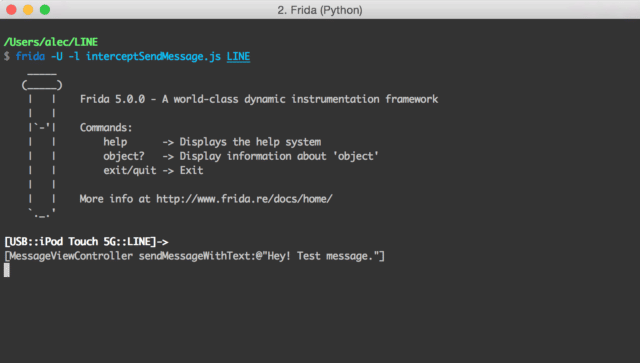Frida is basically Greasemonkey for native apps, or, put in more technical terms, it’s a dynamic code instrumentation toolkit. It lets you inject snippets of JavaScript into native apps on Windows, Mac, Linux, iOS and Android. Frida also provides you with some simple tools built on top of the Frida API. These can be used as-is, tweaked to your needs, or serve as examples of how to use the API.

What?
Frida has a whole set of features but the main strengths it has are:
- Scriptable – Your own scripts get injected into black box processes to execute custom debugging logic. Hook any function, spy on crypto APIs or trace private application code, no source code needed!
- Stalking – Stealthy code tracing without relying on software or hardware breakpoints. Think DTrace in user-space, based on dynamic recompilation, like DynamoRIO and PIN.
- Portable – Works on Windows, Mac, Linux, iOS and Android. Grab a Python package from PyPI or use Frida through its .NET binding, browser plugin or C API.
Tools
There’s 4 main tools in Frida:
- frida-CLI – This is a REPL interface that aims to emulate a lot of the nice features of IPython (or Cycript), which tries to get you closer to your code for rapid prototyping and easy debugging.
- frida-ps – This is a command-line tool for listing processes, which is very useful when interacting with a remote system.
- frida-trace – This is is a tool for dynamically tracing function calls.
- frida-discover – This is a tool for discovering internal functions in a program, which can then be traced by using frida-trace.
Why?
Here are some use cases in which you could utilise Frida:
- There’s this new hot app everybody’s so excited about, but it’s only available for iOS and you’d love to interop with it. You realize it’s relying on encrypted network protocols and tools like Wireshark just won’t cut it. You pick up Frida and use it for API tracing.
- You’re building a desktop app which has been deployed at a customer’s site. There’s a problem but the built-in logging code just isn’t enough. You need to send your customer a custom build with lots of expensive logging code. Then you realize you could just use Frida and build an application- specific tool that will add all the diagnostics you need, and in just a few lines of Python. No need to send the customer a new custom build – you just send the tool which will work on many versions of your app.
- You’d like to build a Wireshark on steroids with support for sniffing encrypted protocols. It could even manipulate function calls to fake network conditions that would otherwise require you to set up a test lab.
- Your in-house app could use some black-box tests without polluting your production code with logic only required for exotic testing.
How?
Frida’s core is written in C and injects Google’s V8 engine into the target processes, where your JS gets executed with full access to memory, hooking functions and even calling native functions inside the process. There’s a bi-directional communication channel that is used to talk between your app (Python?) and the JS running inside the target process.
On top of this C core there are multiple language bindings, e.g. Python, Node.js, .NET, Qml, etc., and it is very easy to build additional bindings for other languages and environments.
You can download Frida here:
Or read more here.
